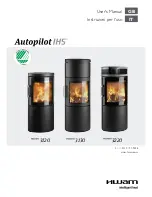
Installation on a Combustible Floor
If the appliance is to be installed on a combustible
floor or a combustible floor covering, it must be
installed on a 1” thick non-combustible millboard
floor protector or a durable equivalent. The pad must
be installed beneath the unit, extending 16” (U.S.) on
the side equipped with a door, and 8” on all other
sides. The pad must cover any horizontal chimney
connector runs and extend 2” beyond each side.
Alternate Floor Protection:
An easy means of determining if a proposed alternate
floor protector meets requirements listed in the
appliance manual is to follow this procedure:
1)
Convert specification to R-value:
2)
Determine the R-value of the proposed alternate
floor protector.
3)
If the overall R-value of the system is greater
than the R-value of the specified floor protector, the
alternate is acceptable.
Example:
The specified floor protector should be 3/4-inch thick
material with a k-factor of 0.84.
The proposed alternate is 4” brick with a C-factor of
1.25 over 1/8” mineral board with a k-factor of 0.29.
Step (a):
Use formula above to convert specification to R-value.
R = 1/k x T = 1/0.84 x .75 = 0.893
Step (b):
Calculate R of proposed system.
4” brick of C=1.25, therefore Rbrick=1/C=1/1.25= 0.80
1/8” mineral board of k = 0.29, therefore Rmin.bd. =
1/0.29 x 0.125 = 0.431
Total R= Rmineral board= 0.8 + 0.431 = 1.231
Step (c):
Compare proposed system R of 1.231 to specified
R of 0.893. Since proposed system R is greater than
required, the system is acceptable.
Definitions:
2. Wall Protection
Please see
Illustration 3
for clearances to walls.
In some areas local codes may require thirty-six
inches (36”) from a combustible, therefore it is very
important that you check with local officials. If you
need to place your unit closer to a combustible wall,
some protection will be necessary. If an approved
wall board is used this will reduce your clearance by
two thirds (2/3); however, a one inch (1”) air space has
to be between the board and the wall. If you have a
ceiling flue hook-up, you will need protection from
the floor to the ceiling if you do not meet the normal
clearances. If you have a wall flue hook up, you will
need wall protection at least twelve inches (12”)
above the wall thimble.
i
R-value is given - no conversion is needed.
ii
k-factor is given with a required thickness (T) in
inches: R = 1/k x T
iii
C-factor is given: R = 1/C
i
Use the formula in step (1) to convert values not
expressed as “R”.
ii
For multiple layers, add R-values of each
layer to determine the overall R-value.
Thermal conductance = C = Btu = W
(hr)(ft2)(ºF) (m2)(ºK)
Thermal conductivity = k = (Btu)(inch) = W = Btu
(hr)(ft2)(ºF) (m)(ºK) (hr)(ft)(ºF)
Thermal resistance = R = (ft2)(hr)(ºF) = (m2)(ºK)
Btu W
Illustration 3
CLEARANCE TO COMBUSTIBLES
Appliance
Clearances
Unprotected Surfaces
Side
(A)
Rear
(B)
Corner
(D)
Connector
to backwall
(C)
Connector
to wall
(corner) (E)
Single wall
connector
R 450
14 in
355 mm
16 in
406 mm
16 in
406 mm
16.75 in
425 mm
16.75 in
425 mm
NOTE: Alcove ceiling minimum height = 48 in
Convection cover (Side Heat Shields )
The AMESTI R- 450 has a cover of the combustion
chamber for generating heat by convection. Also, this
cover act like a heat shield incorporated in hardware.
(Is not necessary to install other piece.)
AMESTI R 450 have refractory bricks just like show the
Illustration 4
Illustration 4
15 refractory bricks: 7.1” x 2.3” x 0.8”
FREESTANDING PLACEMENT
AND INSTALLATION
The first problem you may encounter is getting your
stove into your home -- all of our stove products are
well constructed, which makes them rather heavy.
Three to four adults can normally handle a unit, but
we still recommend using a handcart. Never attempt
to handle a heating product alone!!! The door and
brick can be temporarily removed to lighten the unit
(refer to Brick Layout).
Chimney Connector Pipe
The black pipe must be six inches (6”) in diameter and
at least 24 gauge steel pipe. Do not use aluminum
or galvanized steel pipe, as it will not withstand the
extreme temperatures generated by the stove. Also,
do not use single wall connector pipe as a chimney --
you must connect your stove to a chimney comparable
to those listed earlier in this manual. The crimped end
of your pipe should be inserted into the flue collar
and, by doing this, all the pipe will be reversed. If
you use this method the creosote will run back down
the inside of your pipe and not out of the joints onto
your stove. As a safety precaution, all joints should be
sealed with high temperature silicone
(AC-RTV3)
and
secured with sheet metal screws.
8
9
Содержание R 450
Страница 22: ......






































